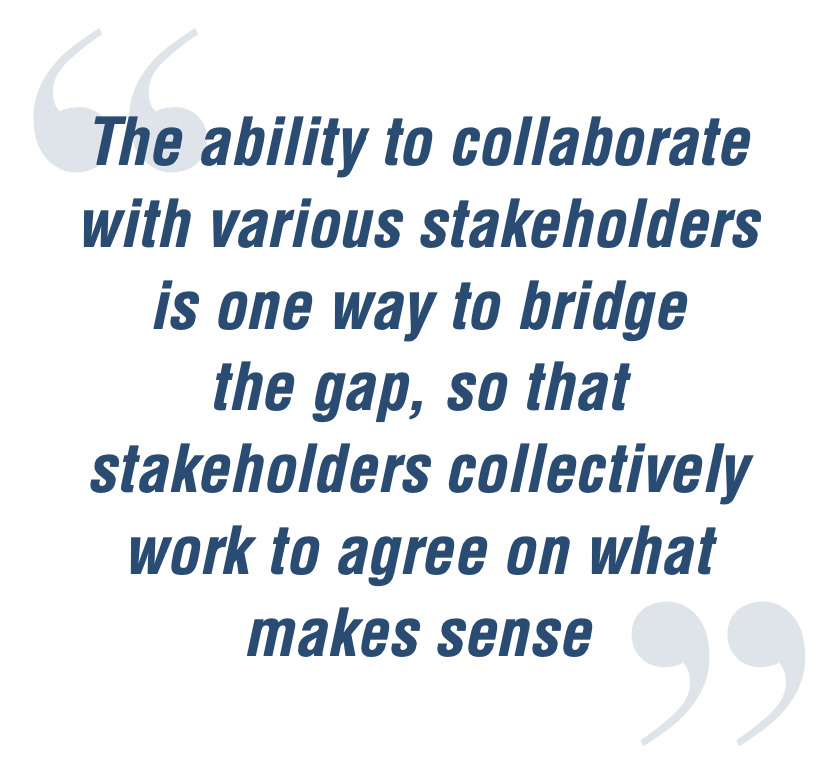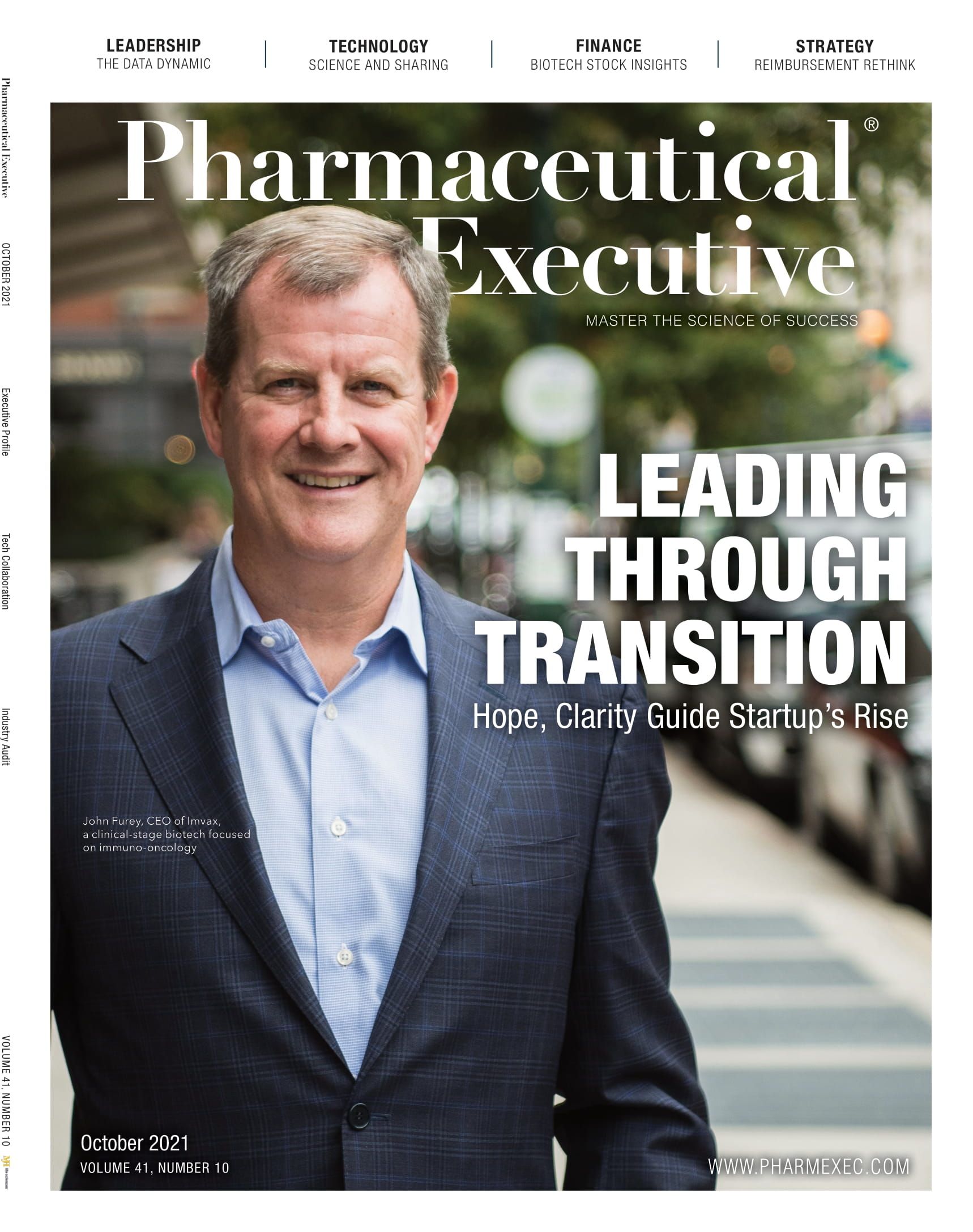Opposites Attract
Unconventional collaborations between biopharma and tech are starting to take off.
When you think about technology and pharma, the industries might seem bipolar. The first stirs images of speed while the second holds a reputation of slowness. However, as the field of data science grows, these industries are noticing the potential of doing business together and unconventional partnerships are being forged.
While some companies have tried to enter the pharmaceutical business on their own, such as Amazon’s launch of Amazon Pharmacy in 2020, others have found working together might be a better route. Tech may be drawn to a relatively recession-proof pharma industry that relies on vast amounts of data, but pharma is equally enamored by tech’s ability to accelerate its business. Both Google and Microsoft have created divisions specifically centered on the life sciences. Combined with novel technologies and a biotech boom fueling innovation, companies of all sizes on both ends are now finding ways to collaborate.
Drivers of change

According to Jay Galeota, Kallyope CEO and Pharmaceutical Executive editorial advisory board member, the industry is at a “unique confluence of three macro trends that are going to shape the next decade of biotech and healthcare, drug discovery, and development.” The first trend centers around biology and an unprecedented ability to understand and manipulate complex systems. The second is around the use of computational analytics and the widespread availability of high-powered often AI-enabled analytical capabilities. The third is advances in materials sciences to create previously impossible modalities, like introducing genes into cells through materially mediated mechanisms, or using lipospheres or microspheres to more accurately deliver therapeutics.
While these elements have existed independently in the traditional biology and drug development space, the analytics/IT/computational analytics space, and the device space, the revolution is in seeing them converge at a pace that’s faster than ever before. And now there are novel companies emerging that recognize this opportunity, whose discovery development platforms are dependent on some of these nontraditional approaches. Innovative biotechs are recognizing that traditional drug discovery and development is no longer enough; they need access to world-class data and analytics, and novel approaches to enable more targeted therapeutic delivery.
The team at Kallyope is integrating multiple sophisticated technologies to provide insights into gut-brain communication—a complex biological process—to target multiple diseases of high unmet need in a fundamentally new way.
“Our approach would not have been possible even five years ago,” says Galeota. “We are combining leading science in biology and chemistry with advanced capabilities in computational analytics and statistical genetics, together with new approaches for the study of human biology on the bench to discover and translate our novel programs. For example, we are utilizing organoids, which are essentially mini-guts in a test tube, to test the effectiveness of various compounds on specific targets. That’s pretty remarkable. This is an example of what is possible when you bring all of these approaches together.”

Though the potential for partnership has been around for decades, the conflicting philosophies of the scientific process and technology development have been a fundamental hurdle. “In the tech world, there is generally an engineering mindset with the belief that if you build it, they will come,” says Galeota. “In science, it’s almost the exact opposite: First, do no harm. In order for pharma to accept something new, it has to have been validated, peer reviewed, pressure tested, and replicated before widespread adoption occurs, which of course is a good thing since safety is paramount, but it does create a basic challenge in merging these fields.”
Galeota is beginning to notice an appreciation for the value of the scientific process for validation and legitimacy on the tech side. On the science side, there’s also an increasing acceptance of tech, for example in new ways to conduct clinical studies and an acknowledgement that the traditional ways of validating something scientifically are sometimes too slow for technology’s current pace.
“Tech partners that understand the scientific process, including the need to be rigorous in their research and to demonstrate in a controlled way the application of their technology may be the most successful partners for pharma,” he says. “For tech companies that want to be life science tech companies or seek to be partnered with innovative biotechs, it’s important to understand how to work with established scientific channels, like medical societies, the publication and presentation process, and peer review. An appreciation for the value of these elements will give them a leg up.”
Another area where pharma and tech need to converge is around speed. Pharma is generally more heavily regulated than tech, so there needs to be a willingness from tech to accept that as part of the process. It’s not a high-speed Silicon Valley tempo where things move at lightspeed; it’s a slower, more methodical orientation. Conversely, pharma is concerned that if novel approaches are adopted that aren’t thoroughly vetted and properly executed, there could be setbacks, the need to rework tasks, or new approaches might not be accepted at all.

“The ability to collaborate with various stakeholders is one way to bridge the gap, so that stakeholders collectively work to agree on what makes sense,” says Galeota. “Having a mutual desire to move in this direction is the common ground that they all share. Trying to do that in a way that’s thoughtful and collaborative and takes into account the various concerns that the different constituencies have would be an important aspect of continuing to advance in this direction.”
Benefits of partnering
The war on COVID-19 has forced enormous collaboration at never-before-seen levels. One area of pharma that could benefit from tech collaboration is in improving the efficacy of already proven therapeutics that could be limited due to toxicities and adverse experiences. For instance, some people might not be able to take a medicine that will help them because the ancillary effects are too debilitating or risky. Some examples are disease areas like CNS-related diseases, depression and anxiety, schizophrenia, immuno-oncolytics, and anti-inflammatories, where effective treatments are frequently dose limited due to side effects and/or adverse experiences.
“If we’re able to find innovative ways to apply the kinds of technologies we’ve been talking about to enable these known interventions to either get the medicine to the target site in ways that are more efficient, which can reduce the systemic exposure levels, or find novel ways to administer directly to the point of interest, that would be beneficial,” he says.
Pharma should also look to tech to develop technologies that can enhance compliance of its therapies. While the industry may excel at scientific innovation, it should outsource its technologic needs to companies with that expertise. Managing medical conditions that are chronic and require the activity of patients, such as diabetes, high blood pressure, and arrhythmias, are possible areas for pharma to start collaborating in digital health.

“My favorite example for this is Roche’s acquisition of mySugr, a startup developing an award-winning diabetes application,” says Bertalan Meskó, MD, Director of The Medical Futurist Institute. “Now the company offers its diabetes medication with a useful smartphone app that is a more attractive package for healthcare providers.”
Partnering to create technological products that people like to use can be incredibly useful to pharma. “Pharma companies are pretty bad at doing that,” says Meskó. “This is justified by the fact that only around half of patients worldwide comply with the therapy they received. At the same time, Apple, Google, and Amazon keep on making products people depend on and use for years. This is a quality that would be beneficial for pharma companies to tap into.”
As the pharmaceutical industry gradually grows more dependent on advanced digital technologies, it can become more efficient and cost-effective, adds Meskó. These are technologies that big technology companies have immense experience with, while pharma companies simply don’t. Thus, tech is realizing an untapped business opportunity to help develop products consumers like to use. It is a niche to be filled.
To see how pharma and tech companies are already helping each other, read our five examples of Collaboration in Action below.
Genmab: Streamlining Research
During Pharm Exec’s June Pharmaceutical CEO Leadership roundtable, Jan van de Winkel, MD, CEO of Genmab called out the importance of new partnerships between biopharma and data science companies to help catalyze breakthrough innovation and more rapidly develop medicines for indications where speed is critical.
One of the company’s most recent innovative partnerships was with data sciences company Tempus. Genmab worked closely with Tempus as a sequencing provider for some of its clinical trials, and the partnership naturally evolved from that relationship. It stemmed from a shared goal to improve the lives of cancer patients with both companies working to explore novel treatment concepts and biomarkers, and the rapid integration of translational data into drug development.

“By building teams that are working together side by side instead of siloed, we have been able to create a unique approach to a research partnership, all with the goal of designing and building better therapeutics,” says Kate Sasser, Senior Vice President and Global Head of Translational Research at Genmab. “Tempus is focused on building the world’s largest molecular and clinical data sets, and we are focused on our goal of developing the best antibodies to transform cancer therapy; therefore, we are perfect partners to move our mission forward as fast as possible.”
Collaborations have always been a big part of Genmab’s mission. In addition to partnerships with biopharma companies, Genmab works with top-tier research institutions. In 2020, the company partnered with the Princeton Catalyst Initiative (PCI) on research projects in specific areas that unlock approaches in translational cancer research, antibody science, and data science. It also was awarded the Dutch Prix Galien last year for its work with private research institutes in the Netherlands to develop robotization to perform large-scale PCR (polymerase chain reaction) screening for COVID-19.
“By leveraging data science, computational biology, and machine learning, our goal is to develop more personalized therapies and bring the right antibody to the right patient at the right time,” says Sasser. “We also intend to utilize data science and digital technologies to maximize our antibody discovery process, do intelligent trial design, communicate to physicians and patients in a more personalized way, and ultimately make a bigger difference in the cancer therapy lifecycle. We believe cross-industry partnership between tech and biotech will lead the innovation that can ultimately benefit the patients.”
Genmab has been investing in digital technology and data science in research and development for several years now. Its scientists and leaders leverage data and digital to drive translational research and precision medicine. Sasser expects the next wave of benefits will be found in in silico drug discovery and development, biomarker identification, digital pathology, and innovative clinical trial design.
“The most successful collaborations happen when each side comes with a shared vision to improve the lives of patients,” she says. “The supercharged, rapid innovation can happen when that passion is also matched with expertise, a get-it-done attitude, and a willingness to aim high.”
Adaptive Biotechnologies: Information Sharing Increases Ability to Pivot
Chad Robins, CEO and co-founder of Adaptive Biotechnologies, also called out his experience with tech partner Microsoft (see below) in Pharm Exec’s June Pharmaceutical CEO Leadership roundtable. The collaboration of the two Seattle-based companies, which began in 2018, combines Adaptive’s advanced sequencing technology and Microsoft’s large-scale machine learning and cloud computing capabilities to map the T-cell immune response to many different diseases. The terabytes of data generated by this partnership and other Adaptive research, is accelerating an innovative era of medicine the company calls immune medicine.

“We are collaborating with Roche/Genentech to use our immune medicine platform to screen, identify, and characterize T-cell receptors against shared cancer antigens from the blood of healthy donors,” says Robins. “Genentech will use these T-cell receptors to develop and manufacture ‘off-the shelf’ cell therapies.”
While mapping T-cell receptors to antigens specific for diseases, like Lyme disease, with the help of Microsoft, Robins wondered if the same process could be applied to COVID-19 to identify its unique immune response signature. He called the Corporate Vice President of Research and Incubations at Microsoft, Peter Lee, and asked if his company would be willing to make a massive investment in this mission without any clear benefit to the company other than being part of a much-needed global solution.
“They were all in,” says Robins. “We shared a similar commitment to being part of the solution. We rapidly expanded our research and began to collect data from the blood samples of people infected with COVID-19 to sequence the genomes and T-cell receptors.”
Soon Providence St. Joseph Healthcare, Illumina, and Labcorp were brought in. The team analyzed the immune responses of thousands of patients, creating ImmuneCODE—the largest open database of immune responses to any disease. It also launched a research tool for vaccine developers, immunoSEQ® T-MAP COVID, to measure the T-cell immune response to vaccines in development, as well as the strength and duration of that response. This work also enabled the launch of T-Detect™ COVID, an early-entrant T-cell test for people to detect past or recent COVID-19 infections.
“COVID has highlighted the importance of partnerships and collaborations between technology and biopharma companies,” says Robins. “The ability to share information quickly as a collective working together allowed for greater impact. And that translates beyond a global pandemic to the diseases many suffer from day to day. What we were able to do with our COVID projects would not have been possible five years ago. As tragic as the pandemic is, we were perfectly positioned through our partnership to tackle this, and now with the insights we have from COVID, we are even more prepared to use this research and data to propel the next generation of diagnostics for a range of diseases.”
Adaptive’s original work with Microsoft continues and it is actively exploring other disease areas, including autoimmune disorders and oncology. In addition, the company is working with a variety of biopharma partners to develop tools across its three core units—life science research, clinical diagnostics, and drug discovery.
Microsoft: Helping Pharma Accelerate Solutions During a Difficult Time
To get the tech perspective of Microsoft’s collaboration with Adaptive, we asked Corporate Vice President of Research and Incubations Peter Lee for his insights.

“About three years ago, we were ramping up our healthcare and life sciences efforts at Microsoft,” says Lee. “We came across a startup called Adaptive Biotechnologies that had just published a paper on DNA in T-cell receptors that can predict, very accurately, what kind of antigen that specific T-cell would bind to. Through various conversations with Adaptive’s Chief Scientist Harlan Robins about this work and how Microsoft could use its technology to advance results, we developed a strategic partnership.”
The ultimate goal of the relationship is to figure out how to decode the language of the immune system—how it detects and coordinates attacks on disease—and then help Adaptive translate that natural diagnostic and therapeutic capability into clinical products using the power of Microsoft Azure, AI, and machine learning.
When Adaptive CEO Chad Robins approached Lee about switching gears to apply the technology to COVID, Lee initially had some reservations about taking on another project, but ultimately saw the value in pursuing it.
“Our research timeline showed we were still more than a year away from our initial goal, and so I personally had some questions about taking our joint project in this direction even though the need for new COVID-19 mitigations was severe,” he says. “Chad Robins, however, really encouraged us all to take on this new direction. We tried it, and it worked in just a matter of weeks. It truly was a real testament, not only to the Adaptive team and our team at Microsoft, but to the whole science community that’s been responding to COVID-19. We were thrilled to be able to get T-cell samples from our medical partners, including Providence, Labcorp, and Illumina to retarget our machine learning pipeline.”
Through the partnership, Microsoft provided its computer science and large-scale machine learning expertise through a dedicated team of researchers, and the technical cloud infrastructure for the sequencing and training of Adaptive’s data with its machine learning models. Adaptive is now rapidly generating tremendous amounts of data.
“With our AI models and cloud-scale computing power, we’ve been able to truncate what would have taken years’ worth of work analysis down to a matter of weeks, accelerating the process significantly to create T-Detect COVID,” says Lee.
Though the companies’ focus was on their COVID-19 work throughout the past year, they are now returning to their broader program.
Google: Quantum Leaps and Bounds
In January, Google and Boehringer Ingelheim decided to partner to apply quantum computing to pharma research and development. The collaboration combines Boehringer Ingelheim’s expertise in the field of computer-aided drug design and in silico modeling with Google’s resources as one of the leading developers of quantum computers and algorithms. It is the first time Google has partnered with a pharmaceutical company in quantum computing.

“Google’s Quantum AI team partnered with Boehringer Ingelheim to focus on researching and implementing cutting-edge use cases for quantum computing in pharmaceutical R&D, specifically including molecular dynamics simulations,” says Shweta Maniar, healthcare & life sciences industry strategy executive, Google Cloud.
As pharma companies increasingly look to technology to empower innovation and fuel progress, increased collaboration between tech and pharma can help accelerate the drug discovery process. For example, Schrödinger is collaborating with Google Cloud to further increase the speed and capacity of its physics-based computational platform for drug discovery and materials science. This partnership effectively triples Schrödinger’s previous throughput and pushes the capacity to the equivalent of the world’s most powerful supercomputers.
Moderna is also working with Google Cloud and Looker, its analytics and business intelligence solution, to break down data silos for researchers across the company, providing a consistent single source of truth. Looker improved visibility across entire studies through simple visualizations of hardset data, allowing teams from multiple sectors to share a common viewpoint and easily access each other’s work. Eliminating the hours needed to manually input these siloed data sets allowed Moderna to provide its clinical operations team with a single view to make real-time informed decisions about enrollment and trial execution.
And Accumulus Synergy, a nonprofit working to develop an information and data exchange platform aimed at transforming how drug innovators and health authorities worldwide interact, is building a suite of cloud-based technology solutions on Google Cloud that both health authorities and biopharma companies can utilize to enhance their data and information exchange experiences to help bring safe and effective medicines to patients faster and more efficiently.
“Personalized medicine and customized treatments, fueled by data-driven insights, are becoming a reality for the industry,” says Maniar. “Technology provides compute, data, and AI/ML [artificial intelligence/machine learning] underpinnings that enable progress in this area, and we expect the opportunities to advance personalized care to grow dramatically in the next five to 10 years. We [must continue to] lay the foundations for future success and open up new opportunities to improve medicine, while meeting regulatory requirements and ensuring the data is secure and protected. As we do so, Google continues to hire industry experts who can articulate opportunities and challenges from the specific perspective of the life sciences industry so that we can build and deploy truly helpful technology.”
GlaxoSmithKline: Investing in Machine Learning Leads to Explosive Growth
Computation is key to the work of GlaxoSmithKline’s AI group. To support its compute power, the company teamed up with artificial intelligence company Cerebras, which produces the largest silicon chip in the world, specifically designed for machine learning.
GSK has seen explosive growth in the amount of complex data being generated both within and outside GSK, and this data requires sophisticated analysis. AI helps decode the data in order to learn from it and advance drug discovery. GSK has established a world-class in-house group over the past two years to achieve this. Cerebras hardware allows GSK’s AI researchers to build larger machine learning models at a faster rate. In particular, GSK uses the Cerebras hardware for building models based on DNA sequences.

“We know targets with genetic evidence are twice as likely to succeed than those that aren’t,” says Kim Branson, Senior Vice President and Head of AI-ML at GSK. “AI and machine learning are helping us to maximize the genetics and genomics data we have amassed in R&D through partnerships, including with UKBiobank, the Broad Institute, and 23andMe, to improve drug discovery and double our development success rates. Our goal is to bring innovative medicines and vaccines to more patients, with greater precision and scale.”
Cerebras provides the hardware to support much of GSK’s work, including analyzing vast amounts of genetic and genomic data that it needs in its research. GSK has already used the CS-1 computer to analyze DNA sequences and predict outcomes of specific genetic mutations.
GSK also works closely with NVIDIA, including with its new powerful supercomputer, the Cambridge-1, dedicated to healthcare and R&D. This will contribute additional computational power and state-of-the-art AI technology to GSK’s drug discovery process.
As the demand grows for data engineers who can operate at the intersection of computer science, pharma R&D, and medicine, GSK recognizes the need for talent development. The company has created academic collaborations to support PhD programs at a number of universities. In addition, it runs a two-year AI Fellows program out of its London AI hub.
“These partnerships are essential, and GSK has put technology at the heart of our R&D strategy for both vaccines and medicines,” says Branson. “We’ve generated more data in one quarter of 2020 than we had in our entire 300-year history—much of this from our genomics experiments.”
Though pharma is still in the nascent stages of AI being used in its R&D, GSK believes it will be increasingly important given its ability to produce and analyze large amounts of in-depth data. The priority is integrating all of the information to discover targets that are more likely to be successful in the clinic and become registered medicines, and in parallel, work to find companion diagnostics to improve the patient experience once medicines are approved.
“AI is a core aspect of our strategy and will be absolutely critical to our success,” says Branson. “We are working hard to deploy it at scale. Partnerships that contribute to our progress in this space are extremely valuable. What improves the likelihood of a successful tech-pharma relationship is being in sync on culture and values, clarity on deliverables, strong alliance and contracting teams on both sides, and frequent communication, with a willingness to continually examine what’s working and adapt.”
Elaine Quilici is Pharm Exec’s Senior Editor. She can be reached at equilici@mjhlifesciences.com.

Is Artificial Intelligence a ‘Product’? Products Liability Implications for AI-Based Products
April 10th 2025As the physical products we use evolve to become increasingly complex, traditional products liability frameworks may not always fit to provide remedies for harm that can result from using novel product types.